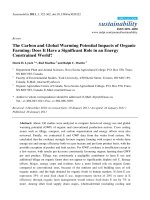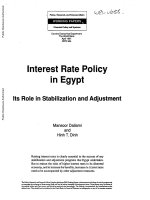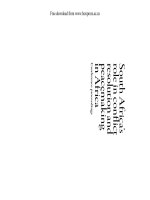Forensic entomology - insects role in criminal and civil laws
Bạn đang xem bản rút gọn của tài liệu. Xem và tải ngay bản đầy đủ của tài liệu tại đây (167.13 KB, 5 trang )
Int.J.Curr.Microbiol.App.Sci (2019) 8(1): 2479-2483
International Journal of Current Microbiology and Applied Sciences
ISSN: 2319-7706 Volume 8 Number 01 (2019)
Journal homepage:
Review Article
/>
Forensic Entomology- Insects Role in Criminal and Civil Laws
A. Appala Raju*
Agricultural College, Bapatla, Acharya N G Ranga, Agricultural University,
Guntur, Andhra Pradesh, India
*Corresponding author
ABSTRACT
Keywords
Forensic, Insects,
Criminal, Civil,
laws
Article Info
Accepted:
17 December 2018
Available Online:
10 January 2019
Forensic science is the application of science to criminal and civil laws and
the forensic entomology is the science of collecting and analyzing insect
evidence to aid in forensic investigations. The review here encompassed the
brief details on the criminal and civil issues related information that can be
gathered through insects; clues about a crime through insect species
succession; insect groups involved in forensic studies; stages of
decomposition by insect activity and few case studies.
Introduction
The “forensic” word is derived from
Latin “forensic” means „in open court,
public‟, from forum. Forensic science is the
application of science to criminal and civil
laws. The forensic application of entomology
has a long, although sporadic, written history
reaching back to 13th century China, then more
recently, more than a century ago, associated
with medical professionals and pathologists
interested in entomology in France and
Canada (American Board of Forensic
Entomology, 1997). In India, the earliest study
on this subject is believed to be by Mackenzie
in Calcutta (Indian Medical Gazette, 1889)
where observations on dead bodies about the
times of appearance of eggs and maggots
Though not much record is available about
this study in the contemporary literature.
The idea of using insect activity as a means to
catch criminals is not new. In the Yuan
Dynasty (around 1300 A.D.), a Chinese
mandarin named Sung T'zu made the first
recorded observations of the usefulness of
insects in solving crimes. Sung, was the
“forensic authority” of the day. He wrote in
one of the earliest criminology works, entitled
Washing Away of Wrongs, that "during the hot
months, if maggots have not yet appeared at
the nine orifices [of the body], but they have
appeared at the temples, hairline, rib cage, or
belly, then these parts have been injured."
2479
Int.J.Curr.Microbiol.App.Sci (2019) 8(1): 2479-2483
Why are insects used in forensic science?
In most seasons and environments, insects
colonize a dead body almost immediately
after death.
Their rate of development and species
dynamics over time can be used to
accurately determine time since death.
After 72 hours, entomological evidence is
the most accurate method to determine the
elapsed time since death.
The history of forensic entomology
1st recorded use: 13th century China
Became quite commonly used in Europe
throughout the 20th century
Popularity increased in North America in the
1970‟s
Today: used quite extensively and
commonly in homicide investigations.
What can insects infer us relating to clue
for crime
Post mortem interval
Whether the body was moved after death
Whether the body was disturbed
Presence and position of wound sites
If the victim used drugs or was poisoned
Length of time of abuse or neglect in living
victims
The significance of forensic entomology
Forensic Entomology is used to determine
time since death (the time between death and
corpse discovery). The other information may
include i. Movement of the corpse, ii. Manner
and cause of death, iii. Association of suspects
with the death scene and iv. Detection of
toxins, drugs, or even the DNA of the victim
through analysis of insect larvae. Forensic
Entomology is the use of the insects and other
arthropods that feed on decaying remains to
aid legal investigations and mainly involves
three major applications:
1. Identification of insects at various stages of
their life cycle, such as eggs, larva, and
adults
2. Collection and preservation of insects as
evidence.
3. Testifying in court to explain insect-related
evidence found at a crime scene
Practical use of insects or arthropods in
solving crime led to the development of a
separate branch of science, now-a-days known
as Forensic Entomology. Forensic is the use of
scientific techniques to solve crimes, and is
used to describe the work of scientists who
examine evidence in order to help the police
solve crimes (Anderson, 1996). The carcass
decomposition of pig has reported 140
arthropod taxa out of which 83% were insects.
These insects were attracted in the first
instance to the body fluids oozing from natural
opening and to blood or serum escaping from
the wounds. Determining an estimate for the
postmortem interval or PMI (the time between
death and the discovery of the body) using
factors such as insect evidence, weather
conditions, location and condition of the body,
etc often focuses on violent crimes.
Insect used in forensic entomology
The overwhelming majority of the insects
used in forensic studies are the flies and
beetles.
Dipteran
families
namely
Calliphoridae, Sarcophagidae, Muscidae,
Sepsidae,
Sphaeroceridae,
Piophilidae,
Phoridae and Coleopteran families namely
Histeridae, Staphylinidae, Silphidae, Cleridae,
Dermestidae, Tenebrionidae predominate the
scene (Goff and Fly, 2000). According to
Smith (1986) the carrion insects are grouped
into
necrophagous,
coprophages,
dermatophages, predaceous, parasitic and
adventives or incidental species on the basis of
their food preferences which reflects their
ecological role. From the insect carrion the
information on post mortem interval, whether
2480
Int.J.Curr.Microbiol.App.Sci (2019) 8(1): 2479-2483
the body was moved after death, whether the
body was disturbed, presence and position of
wound sites, if the victim used drugs or was
poisoned and length of time of abuse or
neglect in living victims can be obtained.
Stages of decomposition fueled by insect
activity
Developmental data are simply data pertaining
to the duration of development of immature
stages recorded at different temperatures
The developmental stages of serial wave of
flies that colonizes carrion and their key
indication of time of death are depicted in
Table 1. The important environment factors in
corpse decay briefing the time of death was
summarised in Table 2.
Stage
Initial or fresh
:
Bloat
:
Decay
:
Post decay
:
Dry
:
1.
2.
3.
4.
5.
Fresh
Bloat
Decay
Post-decay
Dry (skeletal)
Description
The cadaver appears fresh externally but is decomposing internally
due to the activities of bacteria present before death (0-4 days)
The cadaver is swollen by gas produced internally, accompanied by
the odour of decaying flesh (4-10)
Flesh of creamy consistency, with exposed body parts black. Body
collapses as gases escape. Fluids drain from body. Odour of decay
very strong (10-20 days)
Cadaver drying out. Some flesh remains at first; chessy odour from
butyric acid (20-50 days)
Cadaver almost dry; slow rate of decay. May mummify (50-365
days).
Other applications of forensic entomology
Damage to structures, Clothing, foodstuffs
Location of wounds on a corpse
Linking suspect to scene of crime
Source of contraband
Type of insects can trace vehicle movement
Presence of drugs in corpse
Forensic
The court wants to know whether the new
owner was to suspect on the old one
Case study 1. Estimation of PMI (Arbois,
1985)
Dr. Arbois based on the life cycle of
necrophagous flies found on the body.
Case studies
Entomology
relating
to
This was the first case to determine PMI in
forensic entomology by Dr. Arbois
A mummified body of a child was found by a
owner in an apartment after a week of moving
into the apartment
He found that the death occurred two years
before and the old owner was found to be
guilty of the murder.
2481
Int.J.Curr.Microbiol.App.Sci (2019) 8(1): 2479-2483
Table.1 Developmental stages of flies colonizes carrion
Days after
death
1
2
3
4
5
6
7
8
9
10
11
12
13
14
15
16
17
18
19
20
21
House
fly
EGG
EGG
LARVAE
LARVAE
LARVAE
LARVAE
LARVAE
LARVAE
LARVAE
LARVAE
PUPA
PUPA
PUPA
PUPA
PUPA
PUPA
Blow
fly
EGG
LARVAE
LARVAE
LARVAE
LARVAE
LARVAE
LARVAE
LARVAE
LARVAE
LARVAE
LARVAE
LARVAE
LARVAE
PUPA
PUPA
PUPA
PUPA
PUPA
PUPA
PUPA
ADULT
Flesh
fly
LARVAE
LARVAE
LARVAE
LARVAE
LARVAE
LARVAE
LARVAE
LARVAE
LARVAE
PUPA
PUPA
PUPA
PUPA
PUPA
PUPA
PUPA
PUPA
PUPA
ADULT
Skipper
fly
EGG
EGG
LARVAE
LARVAE
LARVAE
LARVAE
LARVAE
LARVAE
PUPA
PUPA
PUPA
PUPA
PUPA
PUPA
ADULT
Table.2 Time of death can be broadly estimated up to about 36 hours
Temperature
Warm
Warm
Cold
Stiffness
Not stiff
Stiff
Stiff
Time of Death
Death less than 3 h
Between 3-8h
Between 8-36 h
Cold
Not stiff
More than 36 h
Case study 2 (Benecke, 1995)
were found to be of blow fly larvae i.e.,
Calliphora vomirorva
A partly putrefied caukasian woman corpse
found on 6 November, 1995 with only few
adult flies found on the corpse. After removal
of corpse, the room was disinfected using
lysoformin.
At the end of febrauary, 1996, maggots were
found in the neighboring houses. The maggots
The unusual appearance of blow flies after 3
months after disinfection is due to the low
temperature prevailed at the time of
disinfection and maggots have undergone
diapauses in the crevices of the floor and
escaped disinfection by the chemicals
2482
Int.J.Curr.Microbiol.App.Sci (2019) 8(1): 2479-2483
From the laboratory rearing studies of the
maggots collected from the neighbouring
houses estimated the number of generations
of blow flies revealed that the death occurred
on 13/9/95 i.e., during September, two
months prior to the recovery of the body.
part of the forensic team, have necessitated
the need for an increase in awareness of
emerging sciences like forensic entomology
and its applications in forensics.
Case study 3 (Benecke, 1995)
Aggarwal AD. 2005. Estimating the
postmortem interval with the help of
entomological
evidence
(thesis
submitted to the Baba Farid University
of Health Sciences, Faridkot, 2005 for
MD in Forensic Medicine). Anil
Aggrawal's Internet Journal of Forensic
Medicine and Toxicology, Vol, 6(2) Pp.
350-380.
American Board of Forensic Entomology.
Welcome to the World of Forensic
Entomology. [Available: World Wide
Web,
/>entomology/ index.html. 1997.
Benecke M.1998. Six Forensic Entomology
Cases: Description and Commentary.
Journal of Forensic Sciences 1998;
43(4): 797-805.
Byrd J H and Castner J L. 2000. Forensic
Entomology: The Utility of Arthropods
in Legal Investigations. CRC Press,
Florida. 1st ed.; Pp. 1-220.
Goff M L and Fly. 2000. A for the
Prosecution. Harvard University Press,
Cambridge, 2nd edn, Pp. 1-225.
Smith K G V. 1986. A manual of Forensic
Entomology. The Trustees of British
Museum (Natural History), London.
1986; Pp. 1-205.
Youngsters who was a drug addict was found
dead and his body was found in woods early
in the morning at 7 AM and it was not there
the previous night until 10 PM.
The autopsy report stated that the death
occurred due to drugs.
The maggots of Lucilia and Calliphora were
found in corpse.
The calliphora does not lays eggs during
night. Hence, the forensic reports came to a
conclusion that the body was shifted to the
woods from elsewhere.
The friends of the body shifted to the body to
woods as they wants to escape the enquiry.
In conclusion, science, Forensic entomology
is an emerging field in forensic sciences,
where the insects feeding on corpses are
studied. It has become an important tool in
criminal investigations. In the present
scenario, the role of forensic odontologists is
not confined to hard tissue examination alone.
Increased instances of forensic odontologists
being involved in criminal investigations, as
References
How to cite this article:
Appala Raju, A. 2019. Forensic Entomology- Insects Role in Criminal and Civil Laws.
Int.J.Curr.Microbiol.App.Sci. 8(01): 2479-2483. doi: />
2483









